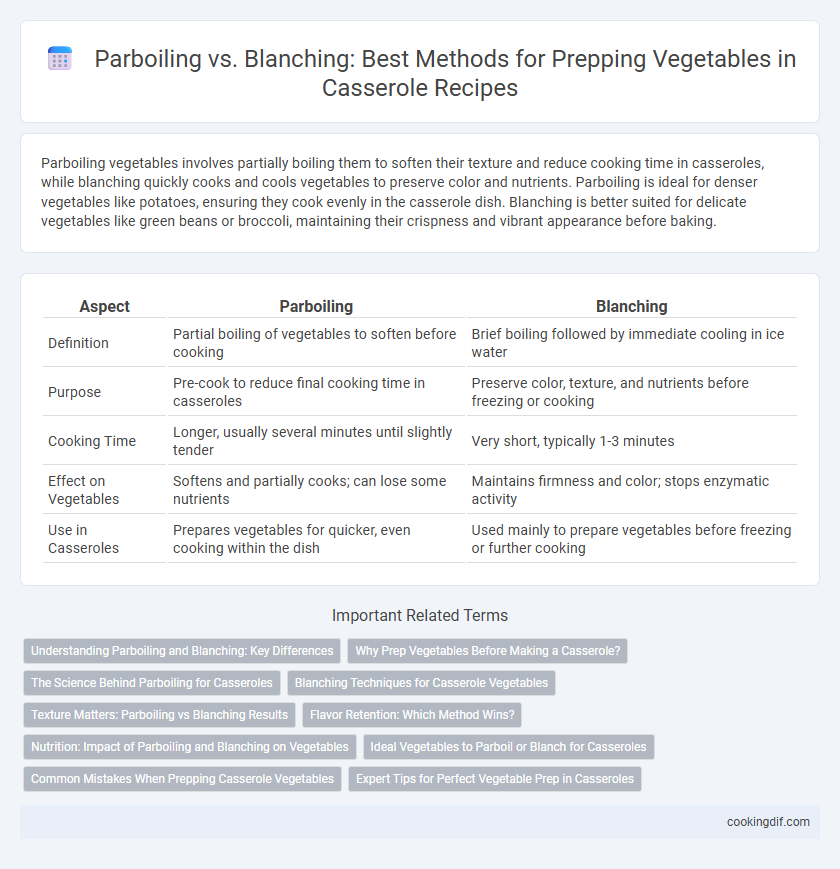Parboiling vegetables involves partially boiling them to soften their texture and reduce cooking time in casseroles, while blanching quickly cooks and cools vegetables to preserve color and nutrients. Parboiling is ideal for denser vegetables like potatoes, ensuring they cook evenly in the casserole dish. Blanching is better suited for delicate vegetables like green beans or broccoli, maintaining their crispness and vibrant appearance before baking.
Table of Comparison
| Aspect | Parboiling | Blanching |
|---|---|---|
| Definition | Partial boiling of vegetables to soften before cooking | Brief boiling followed by immediate cooling in ice water |
| Purpose | Pre-cook to reduce final cooking time in casseroles | Preserve color, texture, and nutrients before freezing or cooking |
| Cooking Time | Longer, usually several minutes until slightly tender | Very short, typically 1-3 minutes |
| Effect on Vegetables | Softens and partially cooks; can lose some nutrients | Maintains firmness and color; stops enzymatic activity |
| Use in Casseroles | Prepares vegetables for quicker, even cooking within the dish | Used mainly to prepare vegetables before freezing or further cooking |
Understanding Parboiling and Blanching: Key Differences
Parboiling involves partially boiling vegetables to soften them before final cooking, preserving texture and reducing overall cooking time in casseroles. Blanching quickly boils vegetables briefly, then immediately cools them in ice water to halt cooking, which preserves color and nutrients crucial for casserole toppings. Understanding these techniques optimizes vegetable preparation, ensuring ideal texture and flavor balance in casserole dishes.
Why Prep Vegetables Before Making a Casserole?
Parboiling and blanching vegetables before making a casserole ensure even cooking and enhance texture by partially softening ingredients without overcooking them. These techniques help preserve vibrant colors and nutrients, preventing the dish from becoming mushy during baking. Properly prepped vegetables absorb flavors better, resulting in a more cohesive and delicious casserole.
The Science Behind Parboiling for Casseroles
Parboiling vegetables for casseroles partially cooks them through gentle heating in boiling water, which softens fibers and enhances heat penetration during baking without overcooking. This method triggers starch gelatinization, improving texture by breaking down cell walls while retaining nutrients and color better than prolonged boiling. Parboiling also reduces overall cooking time in casseroles, ensuring even doneness and melding flavors effectively.
Blanching Techniques for Casserole Vegetables
Blanching techniques for casserole vegetables involve briefly boiling vegetables and then rapidly cooling them in ice water, which helps preserve color, texture, and nutrients while softening the vegetables slightly for even cooking in casseroles. Unlike parboiling, blanching minimizes nutrient loss and prevents overcooking by halting the cooking process immediately after boiling. Common vegetables for blanching in casseroles include green beans, carrots, and broccoli to maintain firmness and enhance flavor integration during baking.
Texture Matters: Parboiling vs Blanching Results
Parboiling vegetables for a casserole softens them evenly, creating a tender texture that blends well with other ingredients during baking. Blanching, in contrast, quickly cooks vegetables while preserving their firmness and vibrant color, ideal for adding crispness and visual appeal to the dish. Selecting parboiling maintains a cohesive, melt-in-mouth texture, whereas blanching supports a fresher, slightly crunchy bite that enhances the casserole's overall layering.
Flavor Retention: Which Method Wins?
Parboiling vegetables in casserole preparation partially cooks them, but can lead to some nutrient and flavor loss due to longer heat exposure. Blanching involves briefly boiling vegetables followed by immediate cooling, preserving vibrant flavors, color, and crispness more effectively. For optimal flavor retention in casseroles, blanching is the preferred method as it maintains vegetable integrity and freshness.
Nutrition: Impact of Parboiling and Blanching on Vegetables
Parboiling vegetables partially cooks them by simmering in water, which can cause loss of water-soluble vitamins like vitamin C and B-complex, while blanching involves briefly boiling followed by immediate cooling, better preserving nutrients by halting enzymatic activity quickly. Blanching typically retains more antioxidants and phenolic compounds compared to parboiling, making it a preferred method for maintaining the nutritional quality of casserole ingredients. Understanding these differences helps optimize vegetable preparation to maximize nutrient retention in casseroles.
Ideal Vegetables to Parboil or Blanch for Casseroles
Parboiling is ideal for dense vegetables like potatoes, carrots, and green beans, as it softens them partially to ensure even cooking in casseroles without becoming mushy. Blanching suits green vegetables such as broccoli, asparagus, and peas, preserving their vibrant color and crisp texture while reducing cooking time in the casserole. Both methods optimize vegetable texture and nutrient retention, enhancing the overall quality of the casserole dish.
Common Mistakes When Prepping Casserole Vegetables
Parboiling vegetables for casseroles often leads to overcooking, resulting in mushy textures that diminish the final dish's quality. Blanching, a quick boiling followed by immediate cooling, preserves color and crunch but is frequently skipped, causing uneven cooking. Avoiding these common mistakes ensures vegetables retain optimal flavor and texture in casseroles.
Expert Tips for Perfect Vegetable Prep in Casseroles
Parboiling vegetables for casseroles ensures even cooking by partially boiling them until just tender, preserving texture and flavor without over-softening. Blanching involves briefly boiling vegetables followed by immediate cooling in ice water, enhancing color and halting enzyme activity to maintain crispness and nutrients. Expert tips recommend parboiling root vegetables like carrots and potatoes while blanching delicate greens or beans to achieve perfect texture and vibrant appearance in casseroles.
Parboiling vs blanching for prepping vegetables Infographic

 cookingdif.com
cookingdif.com